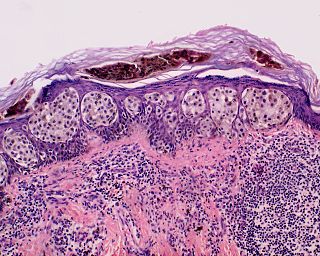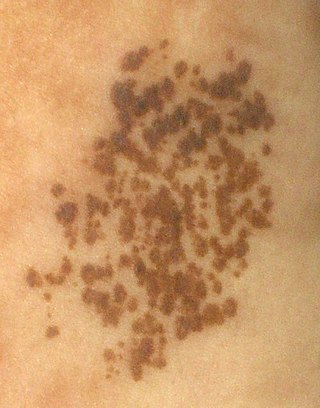
A brain tumor occurs when abnormal cells form within the brain. There are two main types of tumors: malignant (cancerous) tumors and benign (non-cancerous) tumors. These can be further classified as primary tumors, which start within the brain, and secondary tumors, which most commonly have spread from tumors located outside the brain, known as brain metastasis tumors. All types of brain tumors may produce symptoms that vary depending on the size of the tumor and the part of the brain that is involved. Where symptoms exist, they may include headaches, seizures, problems with vision, vomiting and mental changes. Other symptoms may include difficulty walking, speaking, with sensations, or unconsciousness.

Pathology is the study of disease and injury. The word pathology also refers to the study of disease in general, incorporating a wide range of biology research fields and medical practices. However, when used in the context of modern medical treatment, the term is often used in a narrower fashion to refer to processes and tests that fall within the contemporary medical field of "general pathology", an area that includes a number of distinct but inter-related medical specialties that diagnose disease, mostly through analysis of tissue and human cell samples. Idiomatically, "a pathology" may also refer to the predicted or actual progression of particular diseases, and the affix pathy is sometimes used to indicate a state of disease in cases of both physical ailment and psychological conditions. A physician practicing pathology is called a pathologist.

Malignancy is the tendency of a medical condition to become progressively worse; the term is most familiar as a characterization of cancer.
The Institute of Cancer Research is a public research institute and a member institution of the University of London in London, United Kingdom, specialising in oncology. It was founded in 1909 as a research department of the Royal Marsden Hospital and joined the University of London in 2003. It has been responsible for a number of breakthrough discoveries, including that the basic cause of cancer is damage to DNA.

Melanoma is the most dangerous type of skin cancer; it develops from the melanin-producing cells known as melanocytes. It typically occurs in the skin, but may rarely occur in the mouth, intestines, or eye. In women, melanomas most commonly occur on the legs; while in men, on the back. Melanoma is frequently referred to as malignant melanoma. However, the medical community stresses that there is no such thing as a 'benign melanoma' and recommends that the term 'malignant melanoma' should be avoided as redundant.

Acral lentiginous melanoma is a type of skin cancer. It typically begins as a uniform brownish mark before becoming darker and wider with a blurred irregular edge, most frequently seen in the foot of a person with darker skin. It may become bumpy and ulcerate. Just under the nail it typically appears as dark longitudinal streaks, and it may spread.

A benign tumor is a mass of cells (tumor) that does not invade neighboring tissue or metastasize. Compared to malignant (cancerous) tumors, benign tumors generally have a slower growth rate. Benign tumors have relatively well differentiated cells. They are often surrounded by an outer surface or stay contained within the epithelium. Common examples of benign tumors include moles and uterine fibroids.

Superficial spreading melanoma (SSM) is a type of skin cancer that typically starts as an irregularly edged dark spot typically on sun-exposed part of the body. The colour may be variable with dark, light and reddish shades; occasionally no color at all. It typically grows in diameter before spreading to deeper tissue, forming a bump or becoming an ulcer. Itching, bleeding and crust formation may occur in some. The backs and shoulders of males and legs of women are particularly prone.
An oncolytic virus is a virus that preferentially infects and kills cancer cells. As the infected cancer cells are destroyed by oncolysis, they release new infectious virus particles or virions to help destroy the remaining tumour. Oncolytic viruses are thought not only to cause direct destruction of the tumour cells, but also to stimulate host anti-tumour immune system responses. Oncolytic viruses also have the ability to affect the tumor micro-environment in multiple ways.
Many types of skin tumors, both benign (noncancerous) and malignant (cancerous), exist in cats and dogs. Approximately 20–40% of primary skin tumors are malignant in dogs and 50–65% are malignant in cats. Not all forms of skin cancer in cats and dogs are caused by sun exposure, but it can happen occasionally. On dogs, the nose and pads of the feet contain sensitive skin and no fur to protect from the sun. Also, cats and dogs with thin or light-colored coats are at a higher risk of sun damage over their entire bodies.
Clear cell sarcoma of the kidney (CCSK) is an extremely rare type of kidney cancer comprising 3% of all pediatric renal tumours. Clear cell sarcoma of the kidney can spread from the kidney to other organs, most commonly the bone, but also including the lungs, brain, and soft tissues of the body.
The Cancer Institute NSW Premier's Awards for Outstanding Cancer Research are the premier awards ceremony for the cancer research sector in NSW. Now in its tenth year, the event honours the achievements of the individuals and teams that work across the cancer research sector to lessen the impact of cancer for the people of NSW.

Nevus spilus, also known as speckled lentiginous nevus, is a light brown or tan birth mark, speckled with small, dark spots or small bumps. If it occurs in a segmental pattern then it is sometimes referred to as a Zosteriform speckled lentiginous nevus.
A mixed tumor is a tumor that derives from multiple tissue types. A biplastic tumor or biphasic tumor has two tissue types.
The Melanoma Institute Australia is a non-profit organization based at the Poche Centre in North Sydney, Australia which focuses on prevention of and cure for melanoma through research, treatment and education programs. The institute is affiliated with The University of Sydney and St Vincent’s and Mater Health Sydney. It relies on funding from individuals, organisations and government grants.
Ren Michael Pedersen is an advocate for children's brain cancer research.
Georgina Venetia Long is Co-Medical Director of the Melanoma Institute Australia (MIA), and Chair of Melanoma Medical Oncology and Translational Research at MIA and Royal North Shore Hospital, The University of Sydney.

Sarah Coupland is an Australian-born pathologist and professor who is the George Holt Chair in Pathology at the University of Liverpool. Coupland is an active clinical scientist whose research focuses on the molecular genetics of cancers, with particular interests in uveal melanoma, conjunctival melanoma, intraocular and ocular adnexal lymphomas and CNS lymphoma. Coupland is also an NHS Honorary Consultant Histopathologist at the Royal Liverpool University Hospital. Since 2006, Coupland has been head of the Liverpool Ocular Oncology Research Group; from which she runs a multidisciplinary oncology research group focussing on Uveal melanoma, based in the Department of Molecular and Clinical Cancer Medicine at the University of Liverpool. Her research laboratory is currently located in the Institute of Translational Medicine From April 2014 to December 2019, Coupland was also Director of the North West Cancer Research Centre, @UoL. In both 2019 and 2020, Coupland was included on the 'Pathology Powerlist' on The Pathologist website.
Samra Turajlic is a medical oncologist and cancer researcher. She leads the cancer dynamics lab at the Francis Crick Institute in London, which focuses on understanding how cancers evolve, as well as working as an oncologist at the Royal Marsden.

The WHO Classification of Tumours, more commonly known as the WHO Blue Books, is a series of books that classify tumours. They are compiled by expert consensus and published by the World Health Organization's (WHO) International Agency for Research on Cancer (IARC). They appear in print and online in a series of 15 books, each of which focuses on a major tumour group and defines the cause, mechanism, signs and symptoms, basic structure, diagnosis, epidemiology and outcomes of up to 300 types of tumours.









